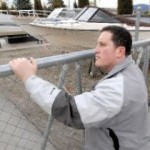Brent Corlazzoli and his partners figure it may be time to sell the 24-foot cruiser they’ve drifted through more than a few hot, summer evenings aboard.
Corlazzoli is one of the original patrons of the Eldorado Yatch Harbour.
He handed over care of his first baby, a Supra water-ski tournament boat, to the dry-dock moorage business on their opening day.
The business is closing after this summer to make room for a high-end condominium development.
While Corlazzoli says he’s looking to find moorage in the city, he is finding his options are really limited.
“Do we put our names in for a slip at the Yacht Club? There’s a wait list of a couple of years,” the Mission area dentist said. “Ultimately, we may just have to sell the boat.”
The Eldorado Yacht Harbour acts like a valet service, parking boat owners’ vehicles on their concrete lot and then launching their boat in the water.
The business will likely relocated—possibly to Westside—leaving city boaters with even less moorage at a time when space at the dock space is already limited.
Kelowna city councillor Andre Blanleil believes the municipality has a responsibility to at least look into the problem.
A regional district plan to do just that is already in the works, but Blanleil says the city should consider taking the matter on as well for residents within its boundaries.
“Not everybody can afford to buy a place on the lake and have a boat there,” he said, as he raised the issue before city council Monday. “…We need to play a leadership role on this side of the lake.”
Westside is already looking into the issue for its residents while the requests for proposals for the regional district study has just wrapped up.
The study contract recipient for the regional district will be asked to look into lake management on three lakes: Okanagan, Kalamalka and Wood.
This marine facilities plan will address everything from boat launches to moorage, issues around finding safe harbour, fueling stations, pump outs for septic tanks and moorage buoys.
So not everyone on Kelowna’s city council sees why the city would need to look at the issue separately.
Characterizing the request as “very vague,” Coun. Robert Hobson said he couldn’t see the “principles” behind it.
“I’m not sure, in my views, it’s necessary for the entire population to be paying for more and more boat moorage,” he said.
“There’s also the issue of the capacity of the lake,” he added. “I’m reaching the point where I think we should be zoning the lake, as other parts of the world do, to deal with some of the conflict that occurs on the lake.”
Hobson said he believes the city is seeing “bigger and bigger, and noisier and noisier” boats each year, and that it causes problems for the sailors and rowers.
As a recreational activity, he not sure providing for power boats is a good use of tax dollars.
Blanleil agreed the taxpayer probably shouldn’t foot the whole bill on the issue, but he said lack of available moorage remains an issue that needs to be addressed.
In the face of housing changes and more families move into smaller homes in the centre of the city, finding ways for the entire community to store their boats and access the lake will only become a bigger problem, he said.
Blanleil was part of a committee who devised a concept plan for Sutherland Bay in the late 1990s. He noted the area would make an excellent alternative for more moorage.
During that same time period, Kelowna’s Inner City Shore Zone Plan was established, though neither document specifically tagged Sutherland Bay as a prime boat launch or moorage area.
At the time, it was assumed the area would be needed for log booms from the mill, said David Graham, City of Kelowna director of recreation, parks and cultural services .
Graham pointed out the mill is still in place and any plans will have to assume things will remain that way for some time to come.
While the regional district study will be conducted this summer; city staff are to return to council before final budget discussions this spring to provide options on how what the city could do to look into the problem for both motorized and non-motorized boaters.

